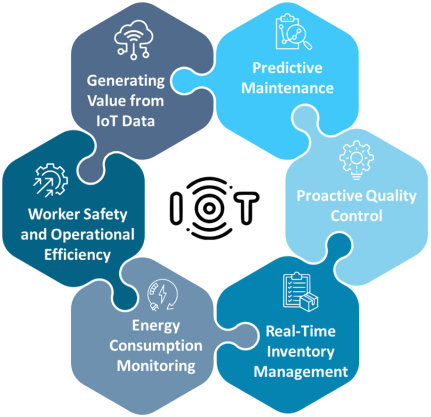The Internet of Things (IoT) is a key element of global industrial transformation, and the manufacturing sector leads in leveraging this technology. The millions of IoT devices, sensors and software on factory floors transforms the traditional factories to smart factories. Machines that can predict maintenance needs and inventory levels that automatically adjust to demand are transforming industries.
IoT-enabled manufacturing provides full visibility of assets, processes, resources, and products. This, in turn, supports streamlined business operations, optimized productivity and improved ROI.
In fact, the IoT in the manufacturing market alone is estimated to generate $87.9 billion in revenue in 2024, with a projected growth rate of 14.2% annually through 2030. A recent Mordor intelligence report indicates that about 35% of US manufacturers believe IoT should be adopted into their operations. It reflects the ever-increasing role of IoT in keeping manufacturing operations agile, responsive, and profitable.
Continue reading the blog to learn how IoT is a key enabler for smart manufacturing and its various use cases.
How Does IoT Enable Smart Manufacturing?
Smart manufacturing is an innovative production strategy that uses IoT, AI, robotics, and data analytics technologies. It aims to create a closely integrated environment where machines, systems, and workers collaborate.
IoT is the digital backbone of the modern manufacturing industry. Imagine thousands of physical devices connected through the Internet, such as sensors, machines, and controls. In simple terms, IoT gives each device a voice.
It enables machines to “talk” to each other and pass real-time data back and forth, like a team of expert analysts working around the clock. This constant flow of information allows manufacturing systems to adjust in real-time, leading to “smart manufacturing.”
Traditionally, manufacturing has relied on manual checks and scheduled maintenance to solve issues, often addressed after they occur.
IoT transforms this by employing a proactive approach that involves the following:
- Monitor key parameters such as machine health, quality checks, and inventory levels.
- Providing real-time, live-streamed data on equipment and processes.
- Early spotting of potential problems.
- Prevention of minor issues from escalating into major disruptions.
Let’s look at how the manufacturing industry benefits from IoT:
- Fewer disruptions in production.
- Lower operational costs.
- Increased employee productivity as routine monitoring is automated.
- Enhanced product consistency due to real-time quality checks.
As it continues to redefine manufacturing, let’s examine how practical applications of IoT can create tangible value across operations. Also read our blog on IoT in 5G mMTC
Deep Dive into Applications of IoT in Smart Manufacturing
The practical applications of IoT are amazingly varied and promising. It offers the manufacturing industry a full-fledged upgrade to efficiency, visibility, and control. Here’s a breakdown of the top ways IoT is making waves in the industry.

1. Predictive Maintenance: Catching Issues Before They Become Problems
IoT can help you with predictive maintenance – which means that your machines can communicate with you if they need attention, or something is about to go wrong.
- Smart Monitoring: Machines are attached with sensors that track their temperature, vibration, and wear to detect issues early.
- Timed Alerts: It lets you know exactly when parts need servicing and avoid costly surprise breakdowns.
- Big Wins: You make considerable saves with less downtime, improved equipment life, and ensuring steady workflow.
IoT-enabled predictive maintenance is a proactive approach which reduces downtime, boosts workflow efficiency, and streamlines maintenance costs, ensuring efficient operations and consistent productivity. By upgrading equipment with IoT sensors and using analytics tools, manufacturers gain real-time insights to plan timely maintenance, prevent costly emergencies, and enhance overall factory performance.
2. Proactive Quality Control: Keeping Quality in Check as You Go
IoT sensors in manufacturing can help you monitor quality metrics throughout production. This means you don’t need to wait until the end to spot issues.
- Real-Time Insights: Sensors measure details like alignment and temperature at each stage to keep quality on track.
- Immediate Corrections: If quality dips, operators can make corrections instantly to minimize production costs.
- Result: With fewer defects and less wastage, ensuring the quality of products becomes more streamlined.
With IoT sensors constantly scanning every production stage, quality control becomes less of a final check and more of a real-time commitment to excellence. For instance, IoT sensors provide real-time updates on deviations, enabling instant adjustments to maintain product standards. This continuous, automated process eliminates delays, prevents minor defects from escalating, and ensures quality assurance operates seamlessly around the clock.
3. Real-Time Inventory Management: Knowing What You Have, When You Need It
IoT sensors provide real-time visibility of stock levels, resulting in streamlined inventory management and helping prevent overstocking and stockouts.
- Live Tracking: IoT sensors and RFID tags can help you monitor inventory across multiple locations.
- Automated Notifications: You are notified on the spot when stock levels are low or when inefficient inventory management occurs.
- Smooth Flow: Helps prevent headaches from overstocking and stock shortages to ensure a streamlined supply chain.
For example, IoT and RFID tags can streamline inventory tracking by providing real-time updates, reducing waste, and preventing stockouts. Cross-channel visibility ensures raw materials and finished products are monitored for smooth production and cost savings. IoT sensors track energy usage across machines, offering actionable insights to reduce costs and promote sustainable practices. This intelligent system eliminates bottlenecks and improves efficiency.
4. Energy Consumption Monitoring: Saving Costs, Reducing Waste
IoT sensors enable manufacturers to monitor energy usage down to each machine to aid decision-making, cut costs, and implement sustainable practices.
- Usage Data: Tracking energy consumption for each machine and process lets you spot and improve upon areas of high energy usage.
- Green Adjustments: Empowers you to make data-driven decisions to improve sustainability and save costs.
- Improve Efficiency: You benefit from lower bills, eco-friendly operations, and optimized energy usage across the board.
Download our success story to learn how Calsoft was engaged with an energy meter device manufacturer to develop a full analytics pipeline and graph visualization for anomaly detection.
5. Worker Safety and Operational Efficiency: Protecting People, Perfecting Processes
IoT has positive implications for equipment management. It can also be leveraged as a tool for safer, better-run workplaces. Below are some of its possibilities in this area.
- Enhanced Workplace Safety: IoT wearables track worker health and location, instantly alerting management to hazards or health issues, ensuring proactive accident prevention.
- Streamlined Operations: IoT automates data collection from machines and workflows, enabling faster decision-making and improving productivity by reducing manual efforts.
- Optimized Resource Utilization: IoT monitors workforce and equipment usage, preventing bottlenecks and ensuring efficient allocation of resources for maximum productivity.
6. Generating Value from IoT Data: Turning Data into Decisions
Along with producing data, IoT is also capable of transforming it into actionable insights. It helps manufacturers to operate smarter at every level.
- Actionable IoT Data: IoT provides real-time insights into machine performance, workflow efficiency, and energy usage, enabling manufacturers to identify trends and inefficiencies quickly.
- Proactive Decision-Making: IoT integrates data into production schedules and maintenance plans, helping address resource shortages or machine issues early to prevent delays.
- Simplified Visualization: IoT transforms complex data into user-friendly dashboards, empowering managers to make informed decisions without sifting through spreadsheets.
With IoT driving innovation across multiple manufacturing areas, also read our blog on PES in IoT
Benefits of IoT for Manufacturing: Visualizing the Big Picture
IoT is not just about fine-tuning processes. It involves helping manufacturers access tools to adapt quickly, stay competitive, and improve in ways that matter to their business and the world.

Flexibility to Meet Changing Demand
IoT provides real-time data that lets manufacturers adjust proactively to shifts in demand. If there is a sudden increase in orders, IoT data can help prioritize resources and anticipate production gaps to prevent downtime. This flexibility helps manufacturers stay aligned with market needs.
Competitive Edge Through Innovation
Manufacturers can implement IoT to move faster and become adaptable in a quickly changing market. The constant data flow from IoT helps you experiment with new features, modify production processes, and tweak products for a competitive edge.
Sustainability Focused Approach
IoT provides sufficient data to identify production and operational inefficiencies and reduce wastage. It helps companies adopt sustainable practices that reduce their environmental impact and lower costs.
Easier Compliance and Tracking
IoT can simplify compliance for industries with strict quality and safety regulations. Sensors automatically track and log data to create an instant compliance record that’s easy to review. It ensures that every step is documented in real time. With traceability ensured from start to finish, audits and quality checks become far less stressful.
Better Roles for the Workforce
IoT frees workers from repetitive monitoring tasks and allows them to focus on more skill-oriented work. Instead of constantly checking machines or manually tracking data, employees can dive into the data insights IoT provides, identifying improvement areas or creatively resolving production bottlenecks
With IoT turning data into decisions, let’s conclude by looking ahead to the future of smart manufacturing.
Conclusion: IoT’s Role in Smarter, Safer Manufacturing
IoT has come a long way in the manufacturing space. It has moved from a buzzword to a vital tool that keeps machines humming, products consistent, and workers safer. Whether predictive maintenance, quality control, or streamlining inventory and energy requirements, IoT is a real game-changer. The real-time insights it offers manufacturers help them stay competitive and efficient.
Calsoft as a Technology-First company is keen to play a significant role in the evolution of IoT technology and help manufacturers find access to innovative, cost-saving applications. If you’re looking to explore IoT’s potential for your enterprise, our array of IoT Services and our end-to-end IoT capability will surely be of interest.






